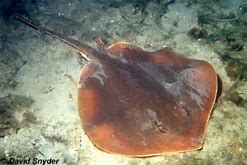I was recently conducting a survey for diamondback terrapins from my paddleboard in a small estuarine lagoon within the Pensacola Bay System. Even if we do not find our target species during these surveys – I, and our volunteers, see all sorts of other cool wildlife. On this trip I was treated to nesting osprey, a kingfisher, large blue crabs, and even a swimming eel. But one neat encounter was the numerous stingrays.

The Atlantic Stingray is one of the common members of the ray group who does possess a venomous spine.
Photo: Florida Museum of Natural History
They were lying in the sand and grassbeds, lots of them, and they all seemed to be of one species – the Atlantic stingray. My brain immediately went to “breeding season”, but when I checked the literature, I found that it was not breeding season, but pupping season – the babies were being born.
Atlantic Stingray (Dasyatis sabina) are true stingrays in the family Dasyatidae. This means they do possess the replaceable serrated venomous barb that makes these animals so famous. They are one of the smaller members of this family. Females can reach a disk width of two feet while the smaller males will only reach about one foot. Atlantic stingrays are a warm water species, migrating if they need to find suitable temperatures. They have been found in water as deep as 80 feet but are more common in the warmer shallower waters near shore. They are very common in our estuaries and being euryhaline (they tolerate a large range of salinity), are found in freshwater systems. There is a population that lives in the St. Johns River. Atlantic stingrays feed on a variety of benthic invertebrates and have special cells in the nose to detect the weak electric fields their prey give off while buried in the sediment. They also like to bury in the sand to ambush prey as they move by.
Breeding occurs in the fall. The smaller males possess two modified fins called claspers connected to their anal fins that are used to transfer sperm to the female. The males have modified teeth they can use to bite the fins of the females. They do this to hold on and make sperm transfer more successful.
The females do not begin to ovulate until spring. So, though they receive the sperm in the fall, fertilization does not occur until the spring. Instead of laying eggs, as some rays and skates do, baby Atlantic stingrays develop within the mother. This is not the same as mammals, who produce a placental to feed the developing young, but more like an internal egg with no hard shell. The embryo is attached to, and feeds from, a yolk sac. Gestation takes about 60 days at which time the yolk sac is depleted, and the young must emerge. Birth usually occurs in late July and early August, and each female will produce 1-4 small pups whose disk are about 10cm (4in.) wide. It was this birthing/pupping period I witnessed.
I returned the following day to search for terrapins and the number of stingrays was significantly fewer. It may be that the birthing process is fast, and the adults leave the coves afterwards. It may have been because that day was the day Hurricane Debby was making landfall east of us and the water levels were abnormally high – something the rays may have noticed and decided to leave – I am not sure.
I was really hoping to see the young rays swimming around – I did not – but plan to search again soon. Stingrays make many people nervous. I witnessed several adult rays whose tails had been cut off – which is very unfortunate – but they are actually cool creatures and fun to watch while paddleboarding. Maybe I will see a baby soon.
References
Dasyatis sabina. 2023. Florida Museum of Natural History. https://www.floridamuseum.ufl.edu/discover-fish/species-profiles/dasyatis-sabina/.
Johnson, M.R., Snelson Jr., F.F. 1996. Reproductive Life History of the Atlantic Stingray, Dasyatis sabina (Pisces, Dasyatidae), in Freshwater St. Johns River, Florida. Bulletin of Marine Science, 59(1): 74-88.
- Our Environment: Part 10 – Improving Agriculture - June 20, 2025
- Marine Creatures of the Northern Gulf – Snails and Slugs - June 20, 2025
- Our Environment: Part 9 – Agriculture Challenges - June 6, 2025
